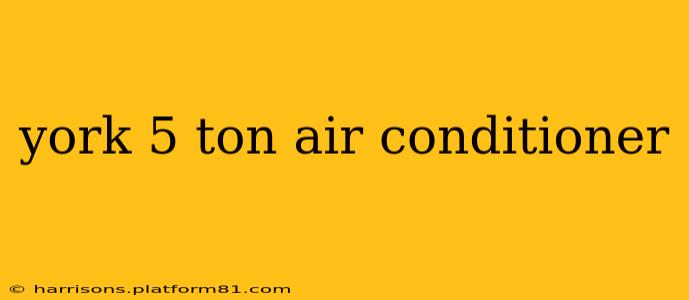Choosing the right air conditioning system is crucial for maintaining comfort and productivity, especially in larger commercial spaces. A 5-ton air conditioner, like those offered by York, is a significant investment, demanding careful consideration. This guide delves into the specifics of York 5-ton air conditioners, helping you understand their capabilities, applications, and key considerations before purchasing.
What is a 5-Ton Air Conditioner?
A 5-ton air conditioner signifies its cooling capacity. One ton of cooling equals 12,000 BTUs (British Thermal Units) per hour. Therefore, a 5-ton unit removes 60,000 BTUs of heat per hour. This makes it suitable for large areas, typically around 1,500 to 2,500 square feet, depending on factors like ceiling height, insulation, and the number of windows. York offers several models within this capacity, each designed to meet different needs and budgets.
What are the Different Types of York 5-Ton Air Conditioners?
York offers a variety of 5-ton air conditioning systems, including:
- Split Systems: These consist of an outdoor unit (condenser) and an indoor unit (evaporator), connected by refrigerant lines. They are popular for their flexibility in placement and quieter indoor operation.
- Packaged Units: These combine both the condenser and evaporator in a single unit, typically installed on a roof or outside wall. They are often simpler to install but may be less efficient than split systems.
- Heat Pump Systems: These can provide both heating and cooling, making them a cost-effective choice in climates with moderate winters. York offers various heat pump models with 5-ton capacity.
The specific model you choose will depend on your building's layout, energy efficiency requirements, and budget.
What Size Space Does a 5-Ton York AC Cool?
Determining the appropriate tonnage for your space is critical. While a 5-ton unit typically handles 1,500 to 2,500 square feet, this is a general guideline. Factors influencing the required tonnage include:
- Climate: Hotter climates require more powerful units.
- Insulation: Well-insulated buildings require less cooling.
- Window Size and Type: Large windows or those facing direct sunlight increase the cooling load.
- Occupancy: A higher number of occupants generates more heat.
- Equipment: Heat-generating equipment (computers, machinery) increases cooling needs.
It's highly recommended to consult with an HVAC professional for an accurate load calculation to determine the precise tonnage required for your specific space.
How Much Does a 5-Ton York AC Cost?
The cost of a 5-ton York air conditioner varies significantly based on the model, features, and installation. Factors influencing price include:
- Type of System: Split systems typically cost more than packaged units.
- Energy Efficiency Rating (SEER): Higher SEER ratings (indicating greater efficiency) generally translate to a higher upfront cost but lower operating expenses.
- Features: Advanced features like variable-speed compressors and smart controls increase the price.
- Installation Costs: These can significantly add to the overall expense.
Getting quotes from multiple HVAC contractors is essential to compare prices and ensure you're getting a fair deal.
What is the Energy Efficiency of a York 5-Ton AC?
York 5-ton air conditioners offer varying levels of energy efficiency, represented by their SEER rating. A higher SEER rating means the unit uses less energy to produce the same amount of cooling. Check the specific SEER rating of the model you are considering. Choosing a high-SEER unit will lead to lower energy bills in the long run.
How Long Does a York 5-Ton AC Last?
With proper maintenance, a well-maintained York 5-ton air conditioner can last for 15-20 years or even longer. Regular maintenance, including filter changes, coil cleaning, and professional inspections, is crucial for extending the lifespan and efficiency of your system.
This guide provides a general overview. For specific product information and detailed specifications, it's always best to consult York's official website or contact a qualified HVAC professional. Remember that proper sizing and installation are critical for optimal performance and longevity.
